On this review, we are taking a deep look at the ASUS ROG Strix XG32VQ. It is ASUS’ latest attempt at a curved gaming display, featuring a 32″ screen space. This is a 144Hz VA panel with a response time of 4ms. The XG32VQ also features the AMD FreeSync technology which is a counterpart of Nvidia’s G-SYNC anti-screen tearing feature. Other notable features includes an RGB capable lighting, a holographic base and game centric features built within the display. Learn more from the official product page and get it at Amazon.
The ASUS ROG Strix XG32VQ is the second curved display to land on my test bench and initial impression of the feature is not exactly the best. That said, ASUS definitely wants me to try out curved displays once again and this time, with a proper panel to look at.
TECHNICAL SPECIFICATIONS:
|
Display |
|
| LCD Size (inch) | 32 |
| Aspect Ratio | 16:9 |
| Resolution | 2560 x 1440 |
| Refresh Rate | 144Hz |
| Display Area(mm) | 697.344 x 392.256 |
| Pixel Pitch (mm) | 0.2724 |
| Brightness (cd/㎡) | 300 |
| Contrast | 3000:1 |
| DCR | NA |
| Panel Type | VA |
| Response Time | 4ms |
|
Connectivity |
|
| Input/Output Connector | HDMI, DisplayPort, Mini DisplayPort 1.2 |
| USB | 2x 3.0, 1x Upstream |
| Ergonomics | |
| VESA Wall Mount | 100 x 100 |
| Pivot | NA |
| Swivel (left/right) | -50°/+50° |
| Tilt (°) | -5°/+20° |
| Hight Adjustment (mm) | 0/100 |
|
Special Features |
|
| Anti-Screen Tearing | AMD FreeSync (48-144Hz) |
| Anti-Motion Blur | NA |
| Profiles | YES |
| Contrast Control | YES |
| Blue Light Filter | YES |
| Black Equalizer | YES |
| Overdrive | YES |
| Speaker | NA |
The ASUS ROG Strix XG32VQ is a WQHD (2560 x 1440) display based on a VA panel. It has a curvature of 1800R, with an aspect ratio of 16:9. The contrast ratio is rated at 3000:1, with a typical brightness rated at 300 cd/㎡. Response time is rated at 4ms GtG and refresh rate is at 144Hz. This gaming monitor support AMD FreeSync with a range of 48-144Hz.
DESIGN, LAYOUT AND CONNECTIVITY:
The ASUS ROG Strix XG32VQ is a 32″ gaming monitor with a curvature of 1800R. It is a huge display with serious gaming aura emanating from its nooks and cranny.
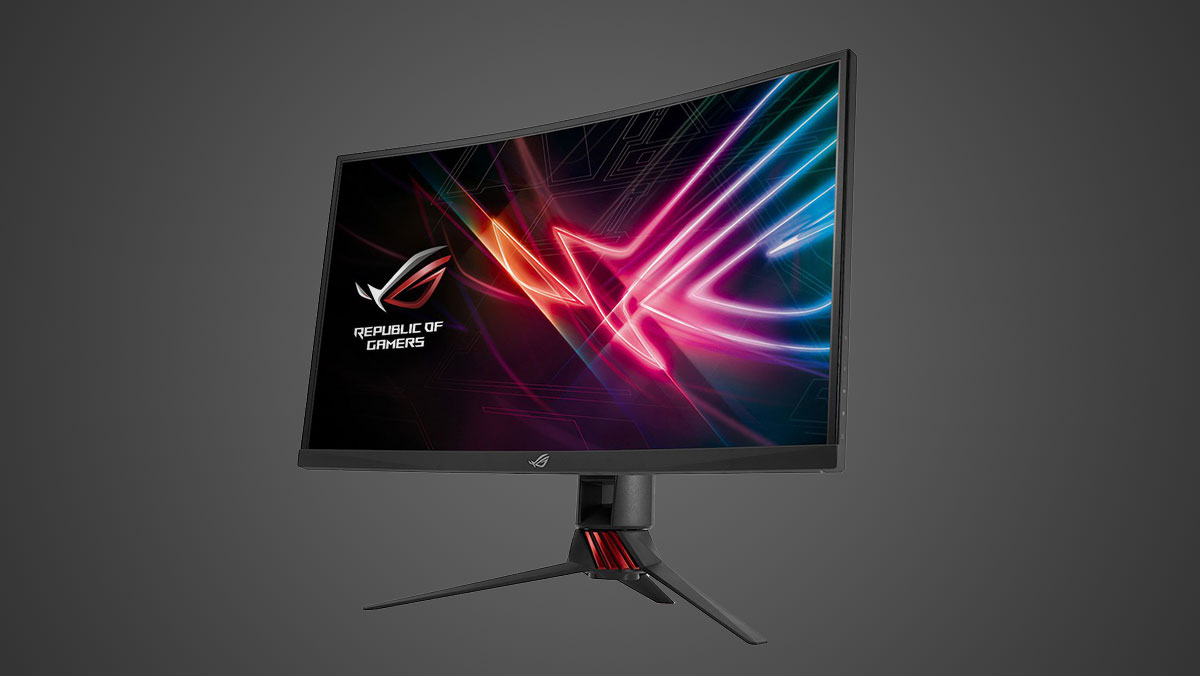
Aesthetic wise, the XG32VQ didn’t even fail to impress. It had the ASUS Aura Sync making sure that everywhere you look, it wont be as bland as a pasta without a sauce. The signature base also adds up to the flare but it does extend the foot print and is still a single color holographic enabled stand. In true ROG fashion, the power and OSD buttons are located at the back.
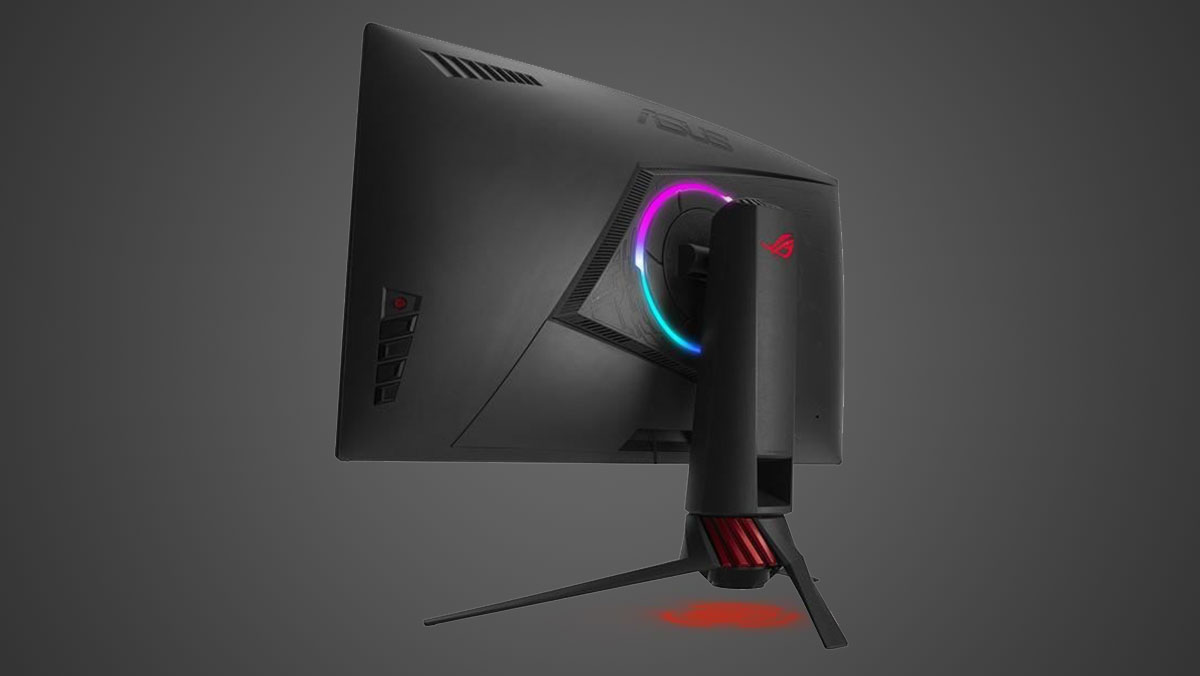
Screen coating used by the ASUS XG32VQ is a blend between gloss and a matte finish. This is to accentuate the color reproduction of the panel while maintaining functionality which is to diffuse ambient light. Bezel on the other hand is around 9.3mm thick (20mm at the base) which is good for multi-monitor setups.
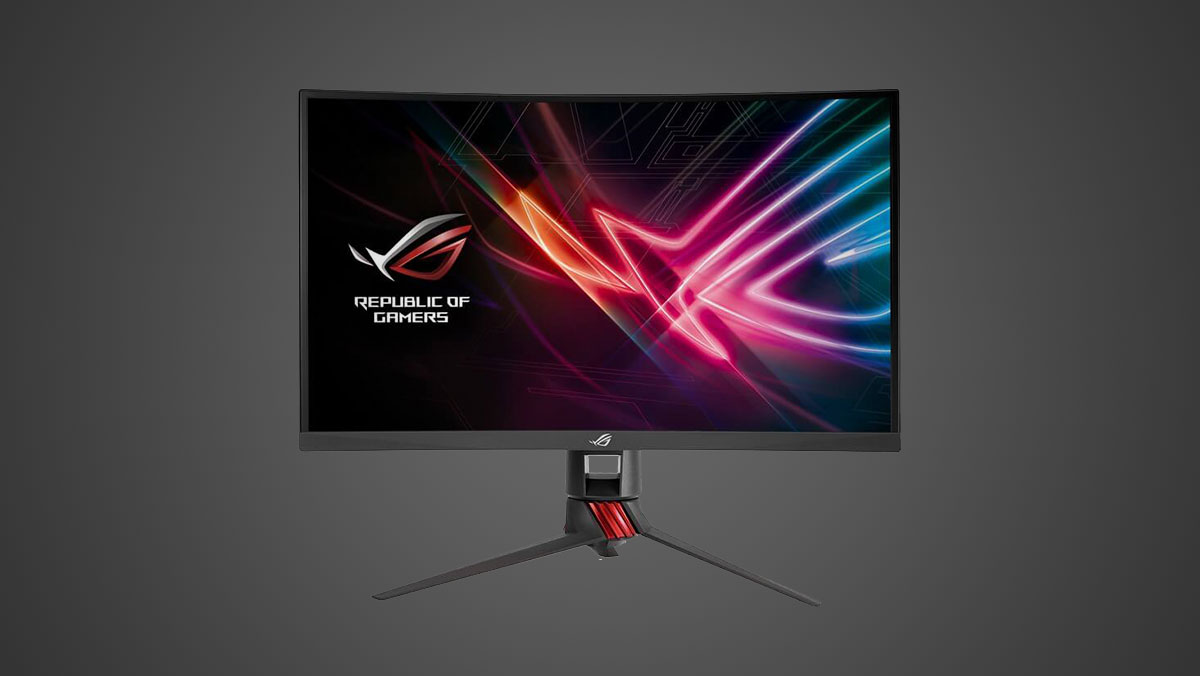
ASUS made sure that the ROG Strix XG32VQ is made with ergonomics in mind. It tilts from -5° to 20° and swivels at a maximum of 50°. Height is also adjustable at a maximum of 100mm.

As for display options, ASUS went extra careful with the choices. We got two DisplayPorts (standard + mini) and a single HDMI 2.0 connector. There is also a USB 3.0 pass-through, a headset jack and a cover to seal the deal. No pun intended.
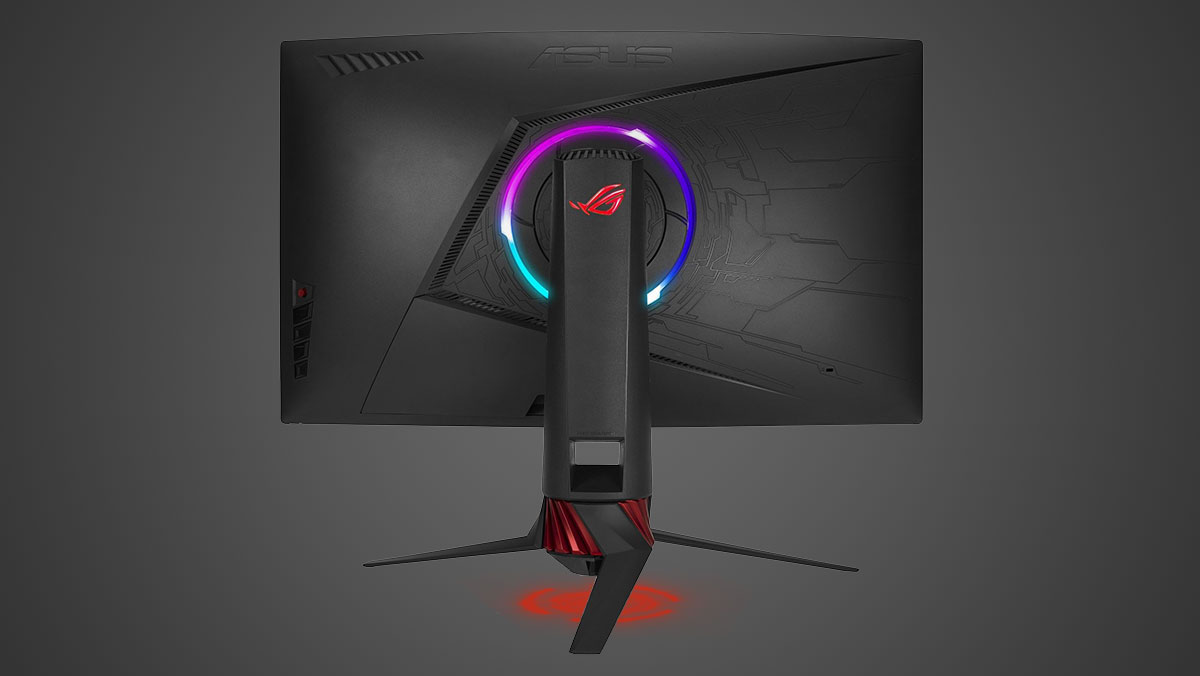
Power is unfortunately still external. A total bummer considering the size of the monitor.
ON-SCREEN DISPLAY MENU:
The ASUS XG32VQ features a similar OSD and navigation option compared to other ASUS gaming monitors we’ve tested. That said, it is easy enough to use especially with a joystick at bay. We have 7 main menus here with GameVisual acting up as the presets menu.

The Image menu is where you’ll find the Adaptive-Sync and FreeSync options. Color is where you of course setup the brightness, contrast saturation and the gamma presets.

Compared to the AOC AG271QG, the XG32VQ’s OSD is a lot more easier to use. I have yet to found ASUS’ match when it comes to navigation.

TEST SETUP, CALIBRATION AND METHODOLOGY:
Our test setup relies on the Blur Busters TestUFO Motion Tests and Data Color’s Spyder5ELITE Display Calibration System. Target for calibration is a 2.2 Gamma value, with a White Point at 6500K and a Brightness value set at 120 cd/㎡. Calibrated values are then analyzed with the Spyder5ELITE Display Analysis tool. Do note that Dynamic Contrast Ratio and other extra features built within the OSD are disabled during the tests.
| TEST SYSTEM SPECIFICATIONS | |
| PROCESSOR | Intel Core i5 6600K |
| MOTHERBOARD | ASUS Z170-A |
| CPU COOLER | Cryorig C1 Top Flow |
| MEMORY KIT | Crucial Ballistix Tactical @ 2666MHz 4x4GB Kit |
| GRAPHICS CARD | ASUS GTX 1060 STRIX OC 6GB |
| INTERNAL STORAGE | Crucial MX200 250GB |
| POWER SUPPLY | CORSAIR RM850X 850W |
| DISPLAY | 27″ DELL U2715H |
| OPERATING SYSTEM | Microsoft Windows 10 Pro |
The cameras used throughout the review for the motion artifact and high speed assessments are the Fujifilm XE-1 and the Nikon 1 J1. The following OSD values are selected for the display calibration. If you wish to use the calibrated ICC profile taken from our Spyder5ELITE result, just send us a message. You may also read our guide on how to use ICC profiles.
| ON SCREEN DISPLAY SETTINGS | |
| Brightness | 84 |
| Contrast | 50 |
| Saturation | 50 |
| Temperature | User (R100, G100, B100) |
| Gamma | Gamma 2.2 |
| Preset | User |
GAMUT:
The Gamut test evaluates the color spaces the display exactly covers. That includes industry standard spaces such as sRGB and AdobeRGB. Higher percentage values are better.
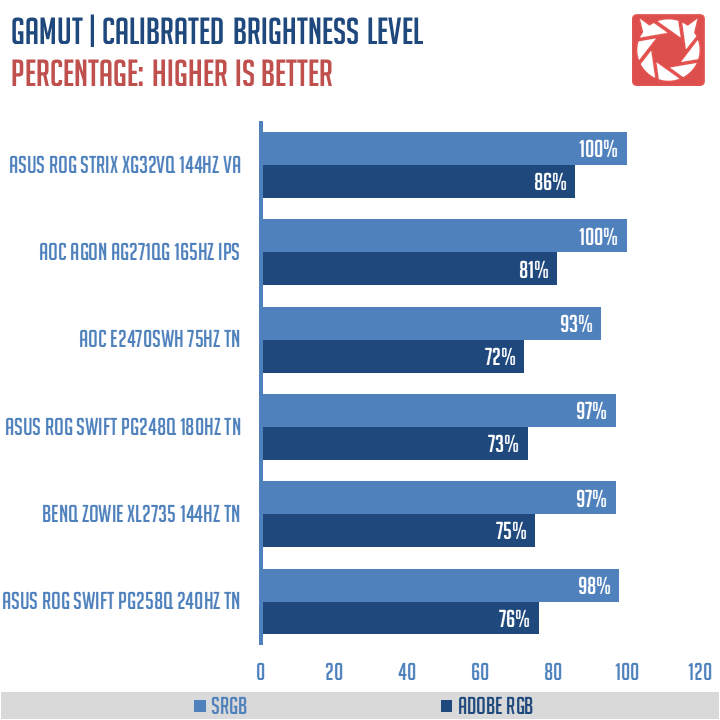
Color space coverage is excellent, as expected from a Samsung VA panel. We’ve got a 100% sRGB coverage while AdobeRGB results are at 86%. Chart topping results we got here with the ASUS XG32VQ.
TONE RESPONSE:
Tone response is where we check the display’s Gamma values and or presets if there are any. We then compare the results with industry standards of 1.8, 2.2 and 2.4. Closer to these values are better.
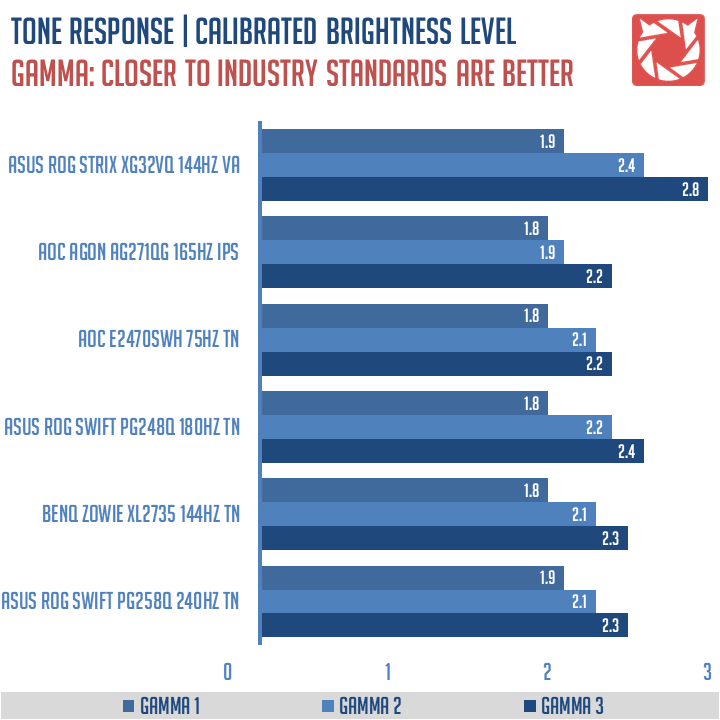
We have 1.9, 2.4, and 2.8 on the scale. Not so good results here, ASUS.
BRIGHTNESS AND CONTRAST:
The result of the tests shows us an overview on how the display actually performs in terms of Brightness and Contrast ratio on varying brightness levels. Higher is better.
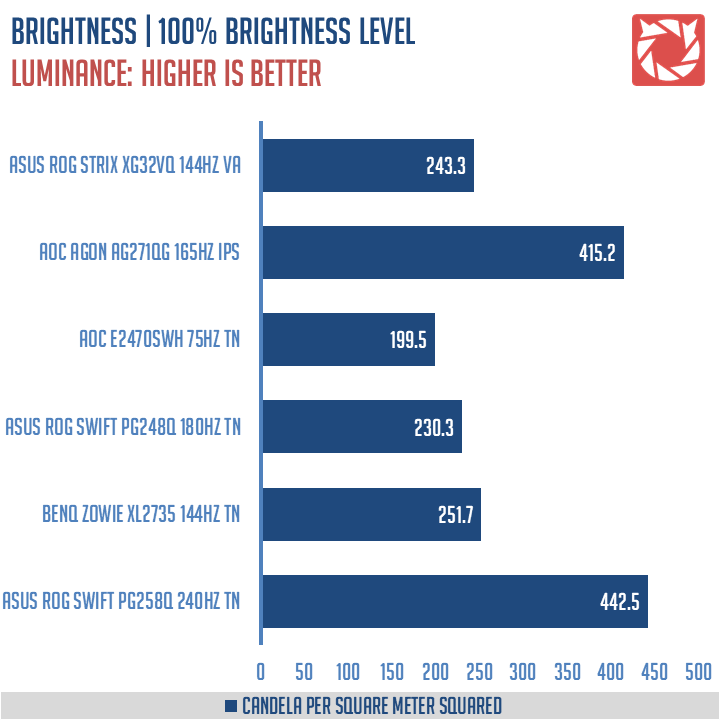
Brightness at 100% is 243.2 cd/㎡ which is 56.7cd/㎡ below the expected figures. Contrast ratio on the other hand is at 830:1. These are values from the calibrated settings.
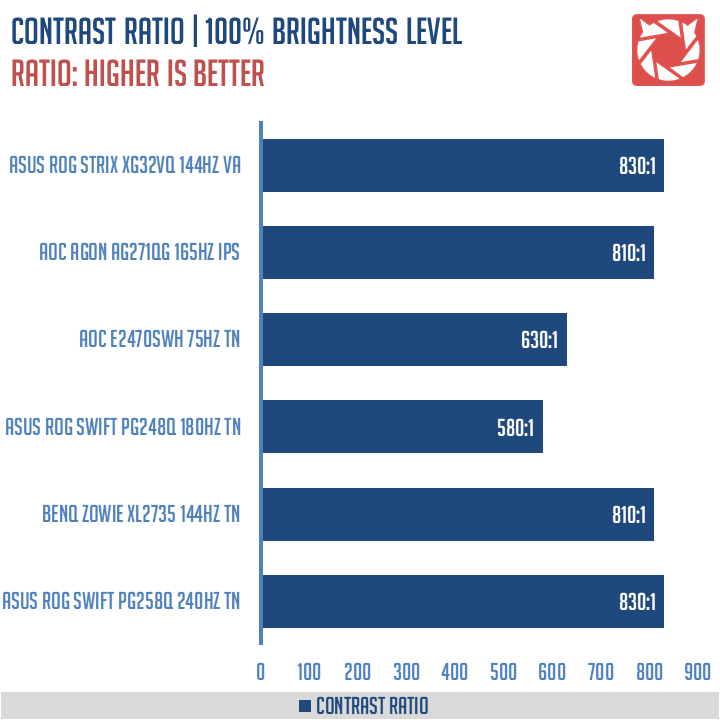
SCREEN UNIFORMITY:
This test shows us an overview of the screen’s uniformity at the calibrated brightness level. The closer this value to 0, the better the performance of the panel.
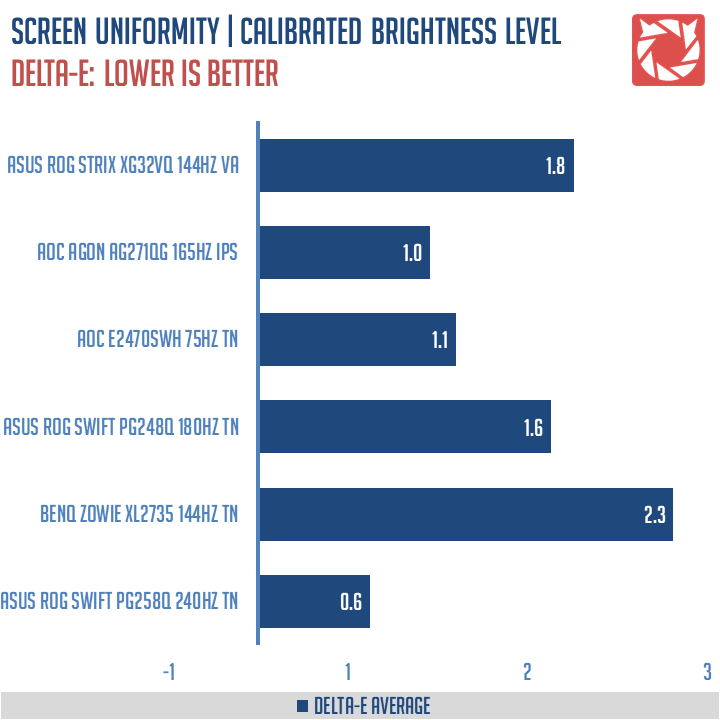
Color uniformity is generally good with decent DeltaE differences across the panel areas. We’ve seen the highest deviation from the lower quadrants of the display at 2.1 max.
COLOR ACCURACY:
This test shows how well different basic color hues are being reproduced by the display. These color tones correspond with the Datacolor SpyderCheckr. Lower Delta-E values are better.
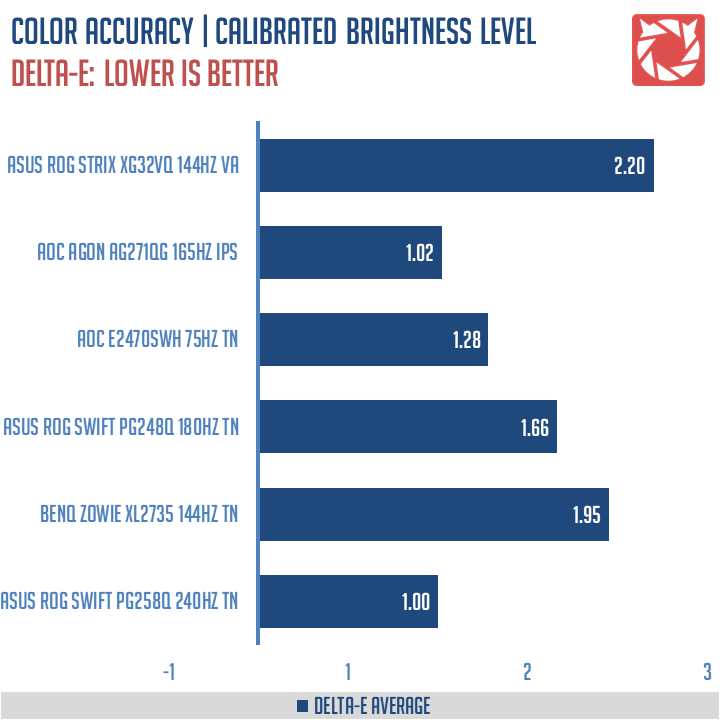
Most color IDs tested hovers below the 1 Delta-E mark, with lighter colors representing the least accurate of all IDs at around 3 Delta-E values respectively. A +100% sRGB space coverage doesn’t mean that a panel is spot on color accurate.
POWER CONSUMPTION:
The power consumption is checked with a power meter. Measurements are taken at maximum brightness level.
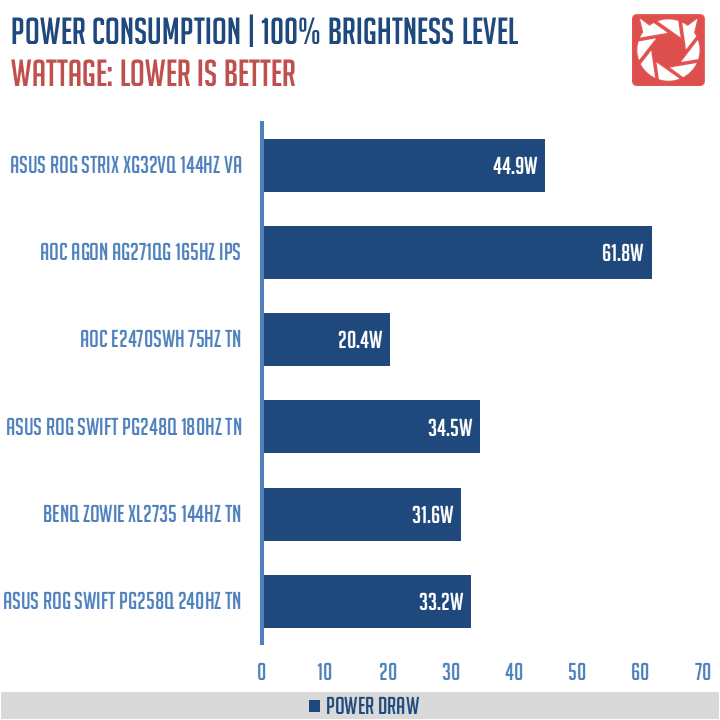
Power consumption is pretty good for a 32 incher. That’s a full 44.9W load at 100% brightness level. Comparable to an average gaming PC while idling.
BACKLIGHT BLEED AND VIEWING ANGLES:
Backlight Bleed is the phenomenon where backlighting from a display leaks. This is prevalent with LED backlight enabled displays where the LEDs used to light the panel are situated at the edges of the display. Testing the Backlight of the display is conducted on a dim room, simulating the recognizable amount of bleed for such scenario.

Viewing angles are also tested to check out how the display panel performs on various positions. This should be helpful if you are looking for a panel that could be used on multi-monitor setups.
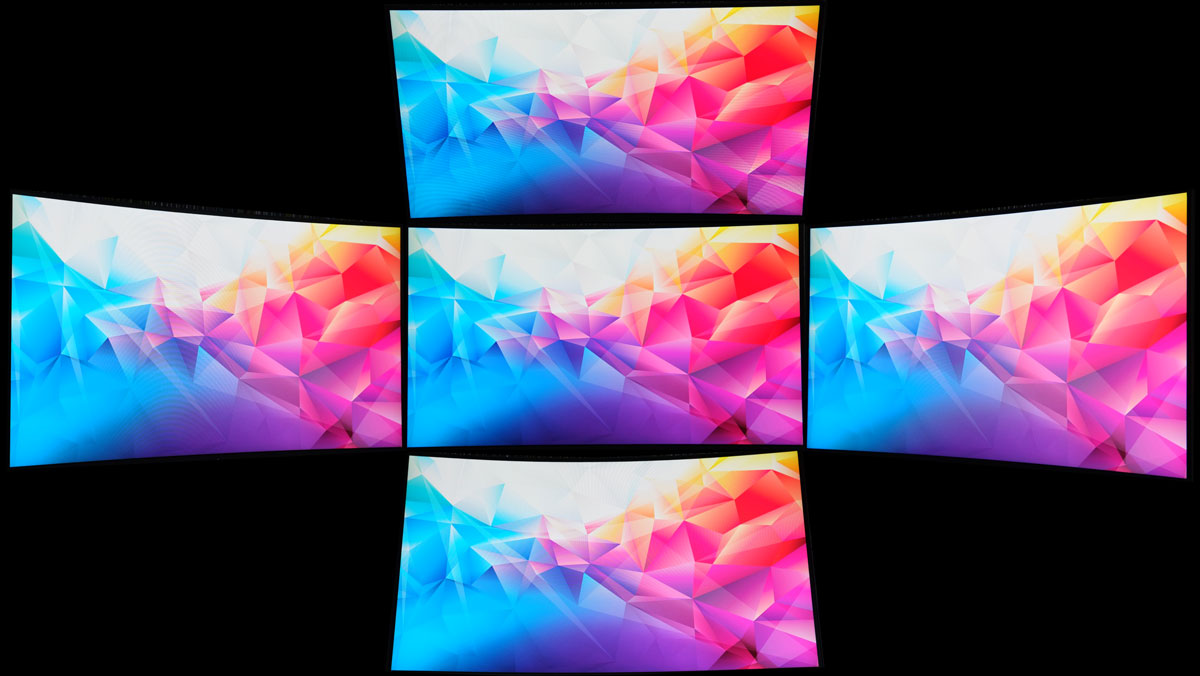
Backlight bleed at 120 cd/㎡ is actually not noticeable at all. Viewing angles are also excellent.
BUTTON TO PIXEL INPUT LAG:
The Button to Pixel Input Lag is a combination of system latency from the point of input, processing and display output. That is the basic of it and to quantify the approximate Button to Pixel Input Lag, we utilized Quake 3 Arena as our main shooter. The game is set at the native resolution of the panel with the FPS locked at 250. We check how much delay in milliseconds it took the display to actually output the signal via a 1200 FPS high-speed camera with ~0.83ms of accuracy.
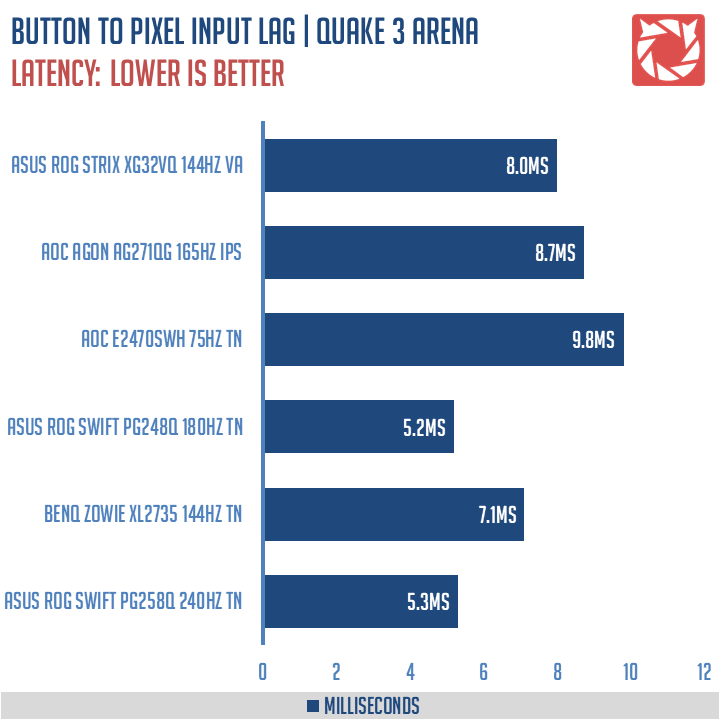
Button to pixel lag results shows that the test system has a minimum of 5.81ms and a maximum of 10.79ms latency. Average through or tests with the high speed camera is at around 8ms.
FRAME SKIPPING:
Frame Skipping is the phenomenon where dropped frames and missing refreshes occur due to ineffective refresh rate overclocking. If your display exhibits such issues, it should be perceptually similar to in-game frame skipping. We are are utilizing the Blur Busters Frame Skipping Checker to test if there is any.
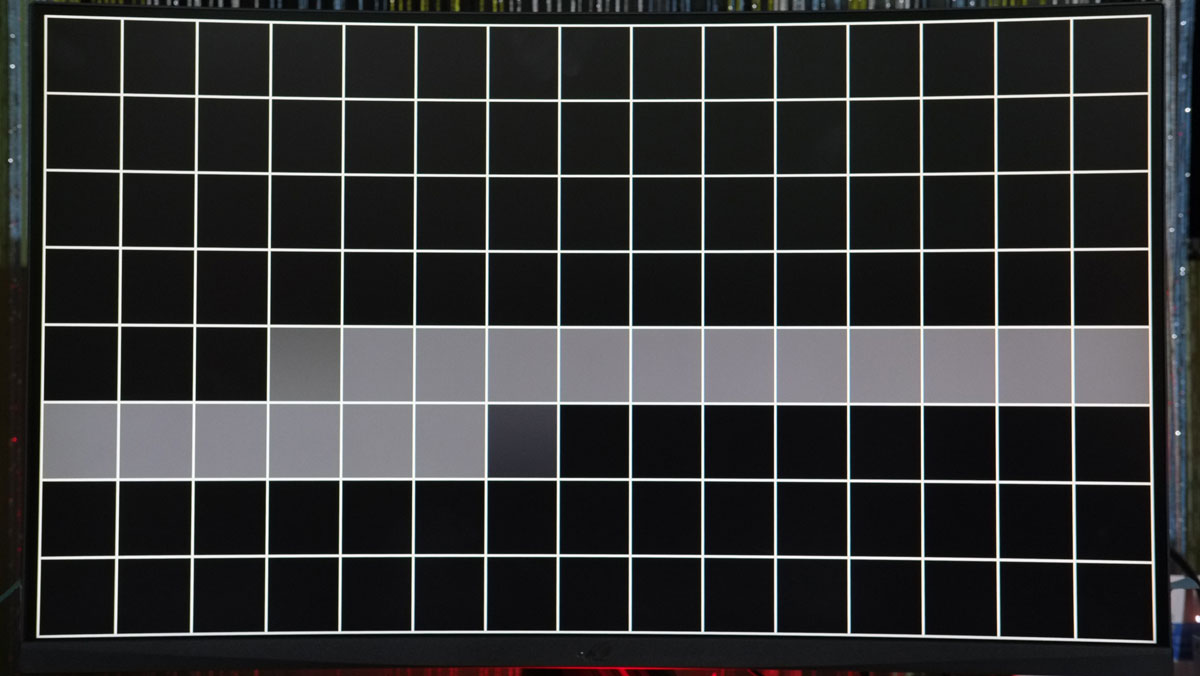
Nothing to worry about frame skipping.
MOTION CLARITY – DISPLAY PERSISTENCE:
Motion Picture Response Time (MPRT) is the numbered approach to demonstrate the level of perceived motion blur on a display. Basically, a lower persistence value indicates less motion blur. Refresh rate and the sampling method plays a major part here whereas a higher refresh rate nominally features better display persistence values.
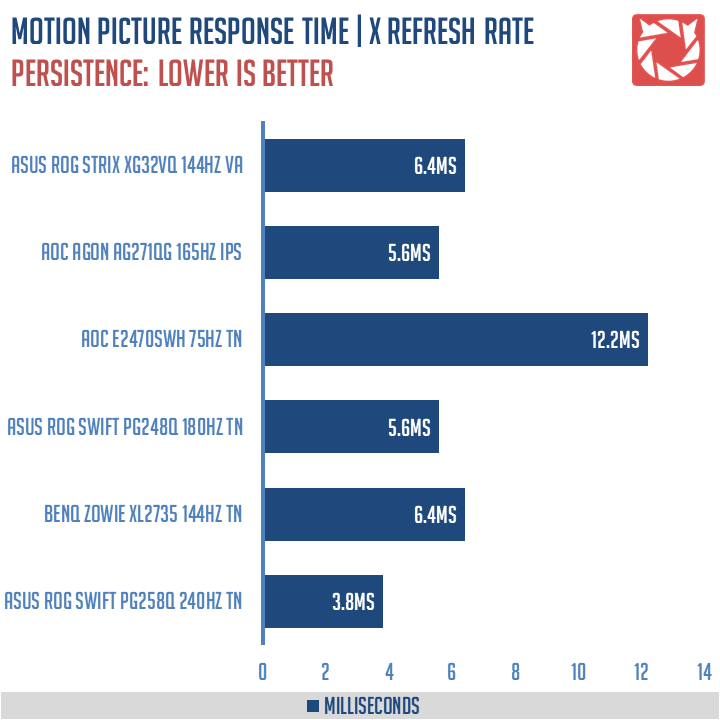
Assessing the typical display persistence is easy enough with sample and hold displays, while CRT and Strobe Lighting enabled displays are quite difficult to test with the current tools available. With that said, use these as references alone.
MOTION CLARITY – PURSUIT CAMERA:
Setting up a pursuit camera courtesy of Blur Busters allows us to a great extent, perceive the actual motion blur of the display. Using such method also allows us to check out for other motion artifacts including ghosting, inverse ghosting and other artifacts. This pursuit camera test is a peer-reviewed invention.
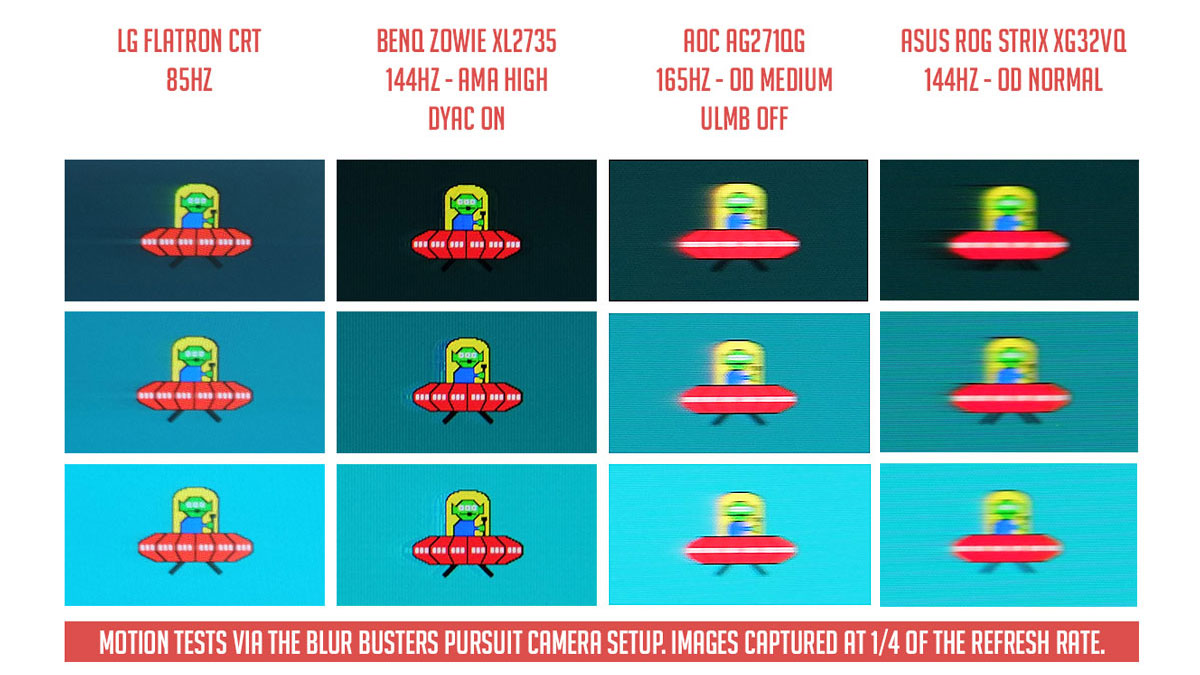
At is native 144Hz refresh rate, the ASUS XG32VQ hinted a motion persistence below 8ms. There are still ghosting even with overdrive but this is the best we could get with the setting at 3 (best). Streaks are more noticeable on darker areas too.
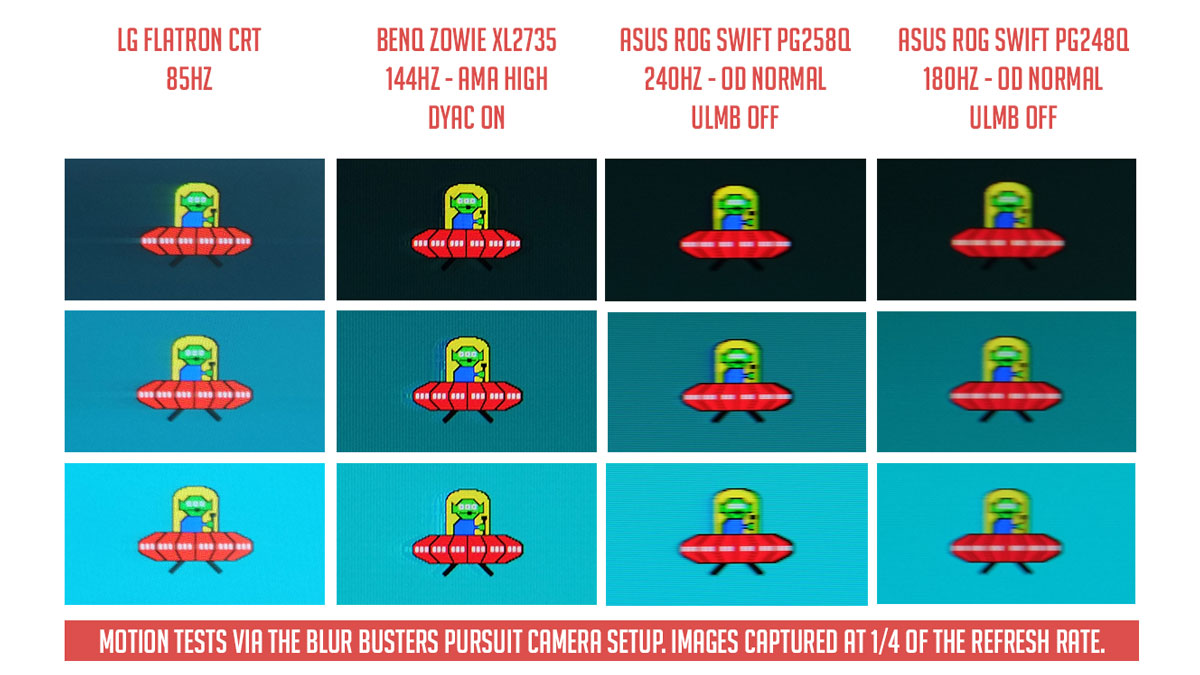
GAMING EXPERIENCE:
This display supports a maximum of 144Hz so it’s pretty smooth and responsive. Sadly, it doesn’t feature ULMB or any sort of blur reduction technology. What it does have though is a 1800R curvature. In practice, curved displays should alleviate eye strain over flat panel displays with an enhanced FOV. This makes more sense with monitors over televisions due to the proximity of the user to feel the difference.
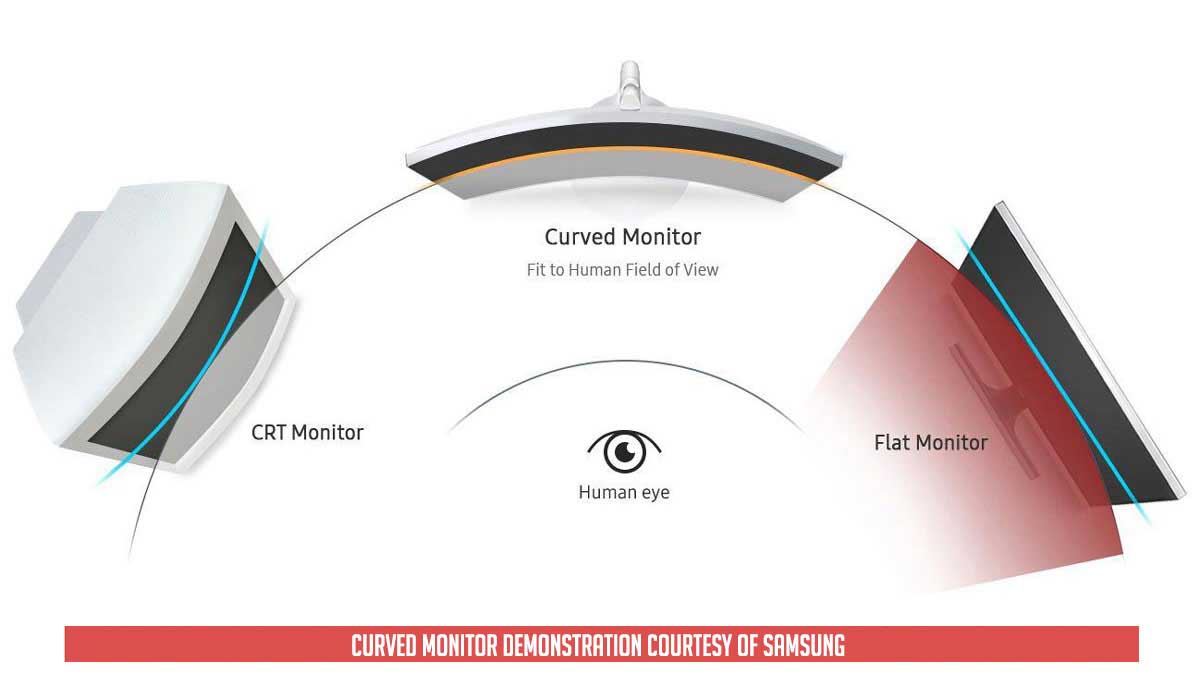
Curved vs CRT and conventional flat screen display
If you’re the kind of gamer who’d trade your soul just to eliminate tearing, then AMD FreeSync is for you. Setting it up is breeze and it’s an excellent way to eliminate tearing. Dipping to lower frame rates and shooting up again also feels smoother with the feature turned on. The ASUS ROG Strix XG32VQ supports FreeSync with a range of 48-144Hz. A good range for a 1440P display.
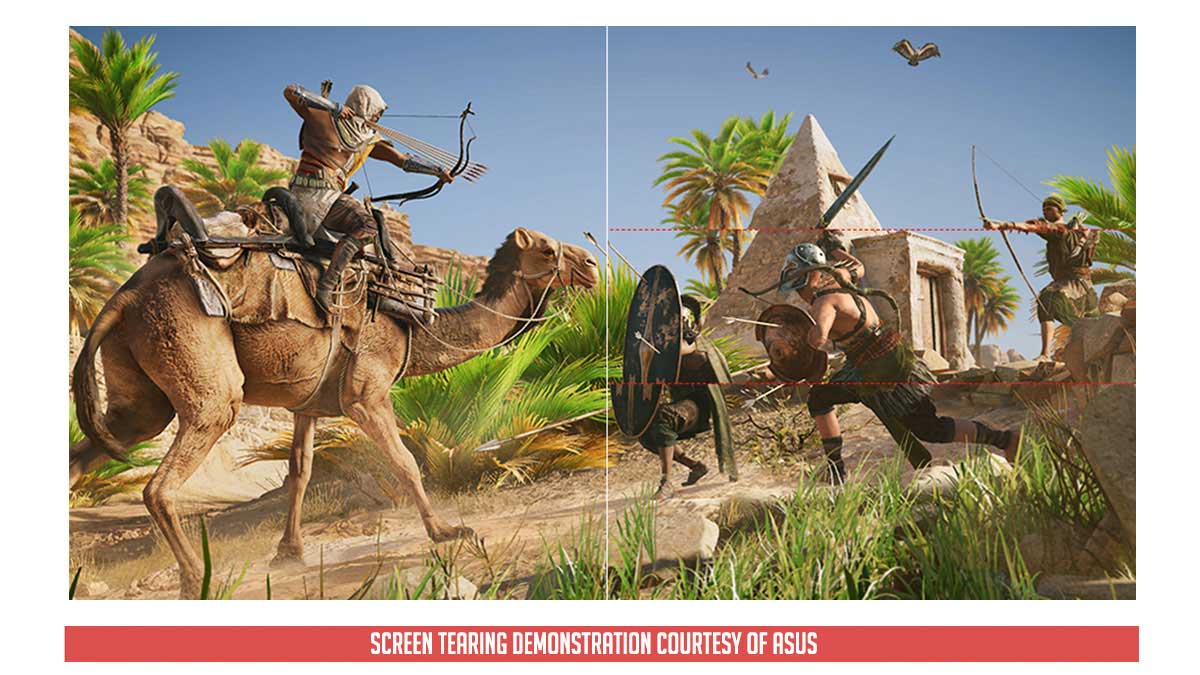
FreeSync display vs normal display with Vsync off
The ASUS ROG Strix XG32VQ features a 32″ display, a 1800R curvature and AMD’s FreeSync at 1440P. Most of the sweet spots are present on this display. That said, it is an enjoyable monitor to play games on. You just have to get used to its curvature at first.
THE VERDICT:
The ASUS ROG Strix XG32VQ is an excellent gaming display but it is not perfect. It passed most of our tests with flying colors with excellent gamut, contrast at calibrated settings and a whole lot more. That includes a reasonable input lag, power consumption and motion clarity. It doesn’t even suffer from horrific backlight bleed. However, it isn’t the best when it comes to tone response and color accuracy. The thing also takes up a lot of desk space but that is expected for a display with such display area.
Gaming oriented features are excellent which is expected for a gaming monitor of this caliber. Though I’d like ASUS to improve the Aura Sync feature. If it’s brighter, it could be used as a proper ambient lighting to sooth the eyes. Lighting is still a plus and boy this is a curved gaming display that I actually like. Again, had this been a 32 incher with a 21;9 aspect ratio, it’ll be a blast to work with.
In closing the ASUS ROG Strix XG32VQ is a competitively priced gaming monitor at 34640 PHP. A gaming monitor that should be on your check list due to its excellent fundamentals regardless of its flaws.
|
|
ASUS ROG Strix XG32VQ 144Hz Curved Gaming Monitor
-
PERFORMANCE - 8/10
8/10
-
BUILD QUALITY - 9/10
9/10
-
FEATURES - 9/10
9/10
-
AESTHETICS - 8/10
8/10
-
VALUE - 8/10
8/10
Summary
In closing the ASUS ROG Strix XG32VQ is a competitively priced gaming monitor at 34640 PHP. A gaming monitor that should be on your check list due to its excellent fundamentals regardless of its flaws.

5